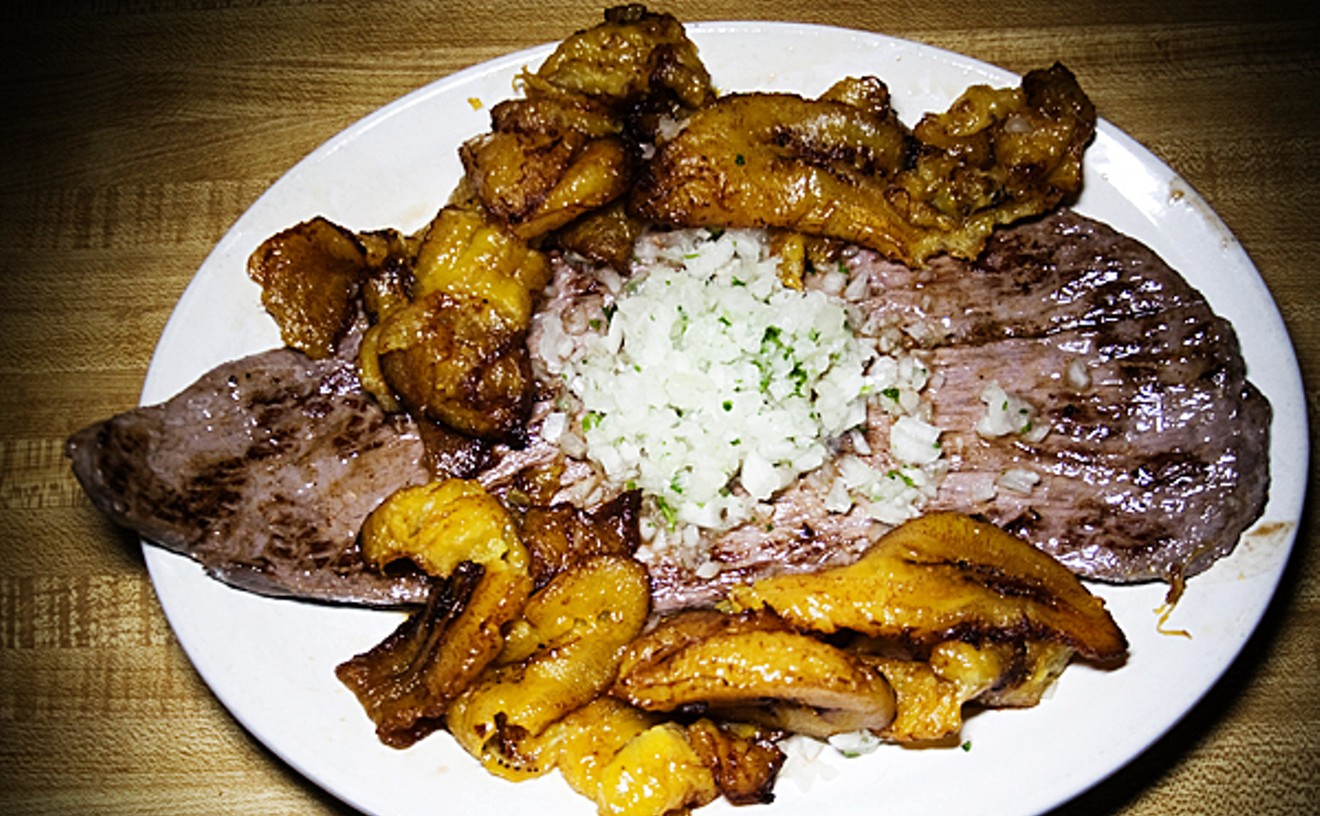Best Batido
Los Pinareños Frutería

When the nostalgia thermometer of a Cuban exile registers a dangerously high level, it usually signifies the person is in a state of hallucinatory shock known as "acaba de llegar." Symptoms include calling all friends socios, having a packed bag that weighs exactly 44 pounds sitting next to the door, and frequently waving a ration book at the man behind the counter at Los Pinareños Frutería. This last behavior is understandable — after all, the open-air fruit stand housing mangos, mameys, guanabanas, nisperos, and coconuts neatly arranged in cardboard boxes held up by long sticks of sugarcane can be easily confused for any Pinar del Río timbiriche. The occasional wandering roosters also don't help. The smartest thing to do if you spot someone in this state of mind is let them be. Order a sapodilla shake, which you won't find anywhere else. Light up a self-rolled cigar. And watch the 90-mile divide wither away.
- 1334 SW 8th St., Miami, 33135 Map
- 305-285-1135
Best Flan
Rio Cristal

Natalia Molina
Like sugar melted into caramel, flan in Miami constantly burns a hole through our hearts. It's so easy to make: eggs, milk, and sugar — maybe a little vanilla or cinnamon — whisked into a custard. And every Latin American country has its own perfected rendition. So why are we constantly subjected to overly creamy masses of what basically amounts to pudding violently infused with corn syrup at even the fanciest restaurants? We expect our flan to jiggle, the loving result of a traditional bain-marie cooking method. And we want it imbued with real sugar, but not such massive amounts that we must schedule several root canals in anticipation. Enter Rio Cristal, an unfancy, greasy-plate Cuban joint whose flan ($3.90) wiggles like a stripper at a Lil Wayne party, sits in a pool of syrup so shimmery it blinds us, and melds into creamy goodness as it restores our faith in "Spanish cheesecake."
- 9872 Bird Rd., Miami, 33165 Map
- 305-223-2357
- www.riocristalrestaurant.com
Best Croissant
Le Royal French Bakery

When in search of French boulangeries where you can twirl your mustache, ponder life's intricacies over a cup of café au lait, and enjoy romantic accordion music in your head, you probably head for Miami Beach. But the French twins who own Le Royal, a tiny café tucked into a strip mall, know better. They had the foresight to predict hungry University of Miami scholars would need butter to function; antsy Sunset Place shoppers would delight in more than six types of croissants; and stressed-out commuters stuck in traffic on South Dixie Highway would require pit stops to refuel on flaky carbs. So the brothers rolled out the pastry dough, kneaded in copious amounts of beurre, and delicately folded glorious petite crescents to create the only pastries in South Miami that sell out by midafternoon. Choose from plain, apple, or almond. Stuff with ham and cheese, guava and cheese, or simply enjoy as light-as-a-feather, billowy bread without garnish. Either way, you'll merci beaucoup us during your next trip to mall hell.
- 7370 Red Rd., South Miami, 33143 Map
- 305-665-6631
Best Empanadas
Che Tano

Argentines are recognized for their meat. In fact, you can find a parrillada serving loads of churrasco, sausage, and ribs in almost any Miami neighborhood. Argentine bakeries are not as ubiquitous, although they should be. Somehow, while the rest of the Hispanic world never thought to venture past chicken and beef empanada fillings, Argentines boldly went where no Latino had gone before. Che Tano celebrates this diversity by offering about 18 kinds of empanadas — double that if you count the fact that you can choose either baked or fried. Think of all the wonderful options: corn, cheese and onions, tuna, and ham, cheese, and hardboiled egg — the list seems endless. While variety might be the spice of life, let's not forget there is still value in tradition. After all is said and done, the beef empanadas (baked and fried) at Che Tano are the stuff that dreams are made of.
- 9564 SW 137th Ave., Miami, 33186 Map
- 305-395-7436
Best Mofongo
Old San Juan Restaurant
In the mainland United States, we have baseball, apple pie, and mom. Substitute mofongo for apple pie and you have a fairly good working list of priorities in Puerto Rico. The Boricua specialty — a heaping mound of mashed fried green plantains studded with crisp pork cracklings — has many incarnations across the island: drenched in tomato sauce, loaded with garlic and onions, or topped with chicken or beef, lobster, or shrimp. Luckily for Miami, mainstay Puerto Rican eatery Old San Juan has just about every variation on the menu. The mofongo con pollo brings a garlicky grilled strip of chicken topped with caramelized onions next to the soft mound of mofongo; order the pulpo and you'll get tender tendrils of octopus with your fried plantains, or the shrimp for a pile of buttery crustaceans on the side. Old San Juan serves its mofongo with a traditional cup of chicken broth for sipping and dipping. Bring a friend — the portions are huge, so even though you're sampling mofongo in the States, there's no way you'll have room for apple pie afterward.
- 1200 SW 57th Ave., Miami, 33144 Map
- 305-263-9911
- www.oldsanjuanmiami.com
Best Cuban Sandwich
Mario's Latin Café

A Cuban sandwich — that majestic combination of ham, roast pork, Swiss cheese, yellow mustard, and pickles — is supposed to be so massive that you can't finish the whole thing. Most restaurants today offer a smaller, contemporary version, but for those of you with a hankering for an old-school sandwich, fear not. Mario's Latin Café on South Dixie Highway in Homestead still serves a heart-attack stack of deli meats and cheese on some of the freshest, softest Cuban bread in town, all for less than $6, 24 hours a day (closed Sunday). Go on — feast like a beast. Your ancestors will be proud.
- 1090 N. Homestead Blvd., Homestead, 33030 Map
- 305-247-2470
- www.marioslatincafe.com
Best Croquetas
Ricky Bakery II

Do not confuse croqueta with croque monsieur — the French grilled ham-and-cheese sandwich — although two traditional fillings of croquetas are indeed ham and cheese. A croqueta likewise has little to do with croquant, which is French for "crunchy," or with croquembouche, a dessert named for the translation "crisp in mouth." Yet the croquetas at Ricky Bakery are very much crisp in the mouth, owing to the breaded, cleanly fried cylindrical casings. Or maybe it is more accurate to say they have some crunch upon first bite, but then the creaminess of the filling takes over. This is true of whatever flavor you choose, be it bacalao (not too fishy), spinach (a unique croqueta filling, and one you shouldn't miss), chicken, cheese, or ham. You can grab them hot from the fryer at opening time (6 in the morning) or at various hours during the day; the cook will also fry 'em to order if you ask. Do not confuse Ricky's croquetas with any others around town. These are better.
- 3115 Coral Way, Coral Gables, 33145 Map
- 786-552-9494
- www.fl-mall.com/ricky/
Best Tapas
El Bocaito

Adrianne D'Angelo
The term tapas derives from the Spanish verb tapar, "to cover." This jibes with at least one history of tapas, which has it that the snack originated as pieces of bread that Andalusians placed atop their sherry glasses to prevent fruit flies from diving in. Sometimes meat, such as ham or chorizo, were used as well; the saltiness increased beverage sales. Another version claims King Alfonso X of Castille, after recuperating from illness via a diet of wine with small dishes of food, decreed that all taverns must serve small bites with drinks. A third rendition of the word's origin is that the owner of El Bocaito, which took over the former Xixón space on Coral Way, invented them last year. Granted, this last theory hasn't gained much traction among historians, but head to this cozy Spanish taverna and sample the chorizo al infierno (with red wine), pulpo vinaretta (marinated octopus), bolaitos de cangrejo (crab fritters), salmorejo Cordobés (cold soup with egg and Serrano ham); almejas a la marinera (baby clams in white wine sauce), or any of the extensive selections ($5 to $12 each), and you're liable to forget about prior versions. This is especially true if you have a few glasses of wine with your meal.
- 1801 Coral Way, Coral Gables, 33145 Map
- 305-856-8818
- www.bocaitospanish.com
Best Taco
Taqueria El Carnal

If tacos — somewhat shaped like mouths — could talk, there would be an argument of such epic proportions that every Mexican restaurant would be forced to give out free earplugs. The (marinated) beef would be between the Tex-Mex version of fast-food chains and the simple, authentic, ungarnished magic offered at a place such as El Carnal. The first, drowning in a sea of sour cream and iceberg lettuce, would be screaming for help, unsure of its identity as it resembles only a shell (a hard, fried one at that) of what it was in Mexico. The second would brag about its slow-marinated carne asada; pineapple-grilled pork al pastor; and seasoned cuts of tongue served in corn tortillas with an assortment of simple sauces from which to choose ($2). It would have all the reason to be smug, self-righteous, and pretentious in its defense of all that is authentic, but — served at a hole-in-the-wall street-food joint with space for only a handful of customers — it would choose instead to be simply welcoming.
- 1128 SW 8th St., Miami, 33130 Map
- 786-287-8950
Best Burrito
Cantina Grill
She stared dejectedly at the empty basket in front of her. "It's gone. It's really gone." No matter how hard she tried, she couldn't fathom how she had fit that entire burrito — almost the size of an infant — inside her petite frame. "I just couldn't stop eating. I tried, but I just couldn't stop." We know, honey. All day long, stupefied customers sit in similar states of awe. The prices at Cantina are cheap (burritos range from $5 to about $8), but the ingredients are almost farm-fresh, the large pizza-size tortillas are made in front of you, and there's a plethora of burrito stuffers. Ingredients include spinach leaves, jalapeños, three kinds of beans, melted cheese sauce or fresh cheese, tomatoes, pico de gallo, guacamole, sour cream, banana peppers, red onions, and on and on. Cantina even offers brown rice and wheat tortillas for those so inclined. Douse your burrito with a half-dozen sauces from the delightful salsa bar. Most important, try the salsa verde, which might be the top tomatillo sauce in town.
- 14713 Bird Rd., West Dade, 33185 Map
- 305-220-3173
- www.cantinagrill.net





